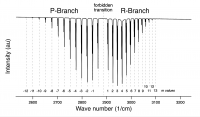Difference between revisions of "HCl Vibrational-Rotational Spectroscopy"
Jump to navigation
Jump to search
| Line 26: | Line 26: | ||
| -12 || XXXX ||YYYY | | -12 || XXXX ||YYYY | ||
|- | |- | ||
| − | | - | + | | -11 || XXXX ||YYYY |
|- | |- | ||
| -10 || XXXX ||YYYY | | -10 || XXXX ||YYYY | ||
Revision as of 13:57, 26 March 2020
Adapted from Experiment #38 (Shoemaker, Garland, Nibler, 1989)
See Chapter 8 (Engel), more will be presented in lecture...
Sample Preparation
- a) Pull the HCl (g) off the headspace of a bottle of concentrated HCl using a 60 mL syringe.
- b) deliver the HCl (g) to the gas-sampling IR cell.
IR Gas-Phase Data Collection
- a) Collect data using the highest resolution.
- b) average 32 scans (both background and sample)
- c) Save-As...
- (A complete set of data can be found here.)
Spectral Analysis
- a) load IR data into Igor or Excel.
- b) Use the cursor tool to tabulate the H35Cl and H37Cl data into separate columns,
- c) Assign an "m-value" to each transition (note the 'm=0' forbidden transition) with the help of the following graphic (click to make bigger).

Data Analysis
Okay, so you should now have a table, probably in Excel but if you know how to do it in Igor then great (Igor does not offer any advantages here) with heading like this:
| m-value | H35Cl | H37Cl |
| -12 | XXXX | YYYY |
| -11 | XXXX | YYYY |
| -10 | XXXX | YYYY |
| -9 | XXXX | YYYY |
| ... | ... | ... |
| +1 | XXXX | YYYY |
| +12 | XXXX | YYYY |
| +13 | XXXX | YYYY |
- d)
- Reduced mass, "mu" = (m1*m2)/(m1+m2)
- 1H 1.007825 amu (99.9885%)
- 35Cl 34.968853 amu (75.78%)
- 37Cl 36.965903 amu (24.22%)
- conversion factor: 1.66054e-27 kg/amu
4) Plot "m" (x) vs the frequency (y) and fit to a second order polynomial.
5) The second order polynomial will take the form of equation 9 from (Exp 38, Shoemaker), hence you can determine alphae, and then of Be.
6) Using equation 5 and 3, then solve for "r" the average internuclear separation.